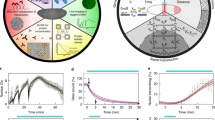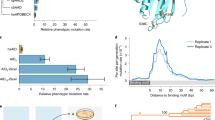Abstract
FLICKINGER1 first pointed out the possible use of actinomycin to find out whether embryonic information transfer is sequential. According to him mRNA for particular organs is “released in the cytoplasm immediately before differentiation”. If this view is correct, it should be possible to suppress the differentiation of organs selectively by treating the embryos (with inhibitors like actinomycin) at specific stages. Ideally, it should be necessary to follow up such experiments with autoradiographic and biochemical tests for suppression of UNA synthesis. Such selective organ suppressions, however, would be interesting per se and hardly any good examples are known. I have reported2 the inhibition of pigmented sensorial organs of Ciona by actinomycin and chromomycin. The latter drug, known to inhibit synthesis of RNA3, also binds to DNA, like actinomycin4,5, and its effects on Ciona are similar to those of actinomycin6,7.
This is a preview of subscription content, access via your institution
Access options
Subscribe to this journal
Receive 51 print issues and online access
$199.00 per year
only $3.90 per issue
Buy this article
- Purchase on Springer Link
- Instant access to full article PDF
Prices may be subject to local taxes which are calculated during checkout
Similar content being viewed by others
References
Flickinger, R. A., Science, 141, 1063 (1963).
Brahmachary, R. L., Acta Embryol. Morphol. Exp., 9, 25 (1966).
Wakisaka, G., Uchino, H., Nakamura, T., Sotobayashi, H., Shirakawa, S., Adachi, A., and Sakurai, M., Nature, 198, 385 (1963).
Kajiro, J., and Kamijama, M., Biophys. Biochem. Res. Commun., 19, 433 (1965).
Kersten, N., and Kersten, H., Biochem. Zeits., 341, 174 (1965).
Brahmachary, R. L., and Reverberi, G., Acta Embryol. Morphol. Exp., 1, 180 (1964).
Brahmachary, R. L., and Reverberi, G., (in the press).
Sherbet, G. V., and Lakshmi, M. S., Proc. Koninkl. Nederl., Akademie van Weterischappen., series C, 67, No. 4, 261 (1964).
Geilenkirchen, W. L. M., and Nijenhuis, E. D., Proc. Koninkl. Nederl., Akademie van Wetenschappen, series C, 62, No. 3, 214 (1959).
Raven, C. P., in Advances in Morphogenesis, 3 (Academic Press, 1964).
Wolsky, A., and Wolsky, M., Biol Bull., 121, 414 (1961).
Gross, P. R., and Cousinean, G. M., Exp. Cell Res., 33, 368 (1964).
Author information
Authors and Affiliations
Rights and permissions
About this article
Cite this article
BRAHMACHARY, R., BANERJEE, K. Information Transfer in Molluscan Embryos. Nature 214, 172–173 (1967). https://doi.org/10.1038/214172a0
Issue Date:
DOI: https://doi.org/10.1038/214172a0
This article is cited by
-
The effect of puromycin on the early cleavage cycles and morphogenesis of the pond snailLymnaea stagnalis
Wilhelm Roux's Archives of Developmental Biology (1975)
Comments
By submitting a comment you agree to abide by our Terms and Community Guidelines. If you find something abusive or that does not comply with our terms or guidelines please flag it as inappropriate.



